Apple iPad Mini vs. Google Nexus 7: What's the Best Small Tablet?

Tablet shoppers are thinking small, with slates that measure less than 9 inches expected to account for more than 66 percent of sales this year. And if you want a tablet you can take anywhere, the iPad mini and Nexus 7 are the two leading options. The latest Nexus 7 from Google packs a class-leading 1920 x 1200-pixel display and dual speakers into a much sleeker design.
On the other hand, the iPad mini is very portable given its larger 7.9-inch display, and there are more than 375,000 apps made for the device. To find out which small slate reigns supreme, we pit the iPad mini against the new Nexus 7 in 13 rounds of battle. Read on to find out which tablet takes home the crown.
Design
While both small tablets feature familiar rectangles, the new Nexus 7 is nice and slim. Measuring 7.9 x 4.5 x 0.34 inches, the width is easier to hold with one hand than the iPad mini’s 7.9 x 5.3 x 0.28 inches. On the other hand, Apple squeezed a larger 7.9-inch screen into a thinner chassis. The front of the Nexus 7 has a lot of wasted space above and below the screen.
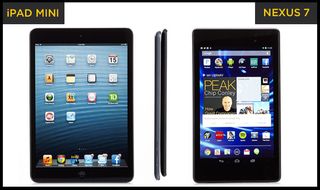
The Nexus 7 weighs less than the mini (10.24 vs. 1 ounces). However, when holding them both the difference is nearly imperceptible. The soft-touch plastic finish on the back of the Nexus 7 is nice, but the sexy aluminum unibody on the iPad mini gives it a more premium feel.
Winner: Apple iPad mini.
The easy-to-hold width of the Nexus 7 makes this a tough choice, but the build quality of the iPad mini puts it over the top.
Display
While Apple’s 7.9-inch tablet sports a relatively low 1024 x 768-pixel resolution, Google’s 7-inch slate packs in a lot more pixels with its 1920 x 1200 display. That means you’re stuck with standard-definition content on the iPad mini, while the Nexus 7 can indulge in high-res goodness.
Google wins in the brightness category. We measured 531 lux, which is nearly 200 points above average and almost 100 points higher than the iPad mini’s 457 lux. Those numbers were proven out when looking at a 1920 x 1200 picture of a black cat. The spots of shine on the fur were much easier to see on the Nexus 7.
Stay in the know with Laptop Mag
Get our in-depth reviews, helpful tips, great deals, and the biggest news stories delivered to your inbox.

In a side-by-side comparison with the Nexus 7 and iPad mini, we viewed a standard-definition trailer of “American Hustle.” The colors, particularly skin tones, appeared richer on the iPad mini, but we could make out more of Bradley Cooper’s curls on the Nexus 7.
When viewing www.tomsguide.com on the iPad mini, we could see significantly more of the site in landscape mode than its competitor. But a 1920 x 1200-picture of a pink flower was richer, more detailed and brighter.
Winner: Google Nexus 7.
While we appreciate the larger size of the iPad mini’s display, the Nexus 7 wins because of its higher resolution and brightness.
Audio
The iPad mini’s dual speakers, placed on the bottom edge, sounded louder and richer than the Nexus 7’s dual speakers on the lower back and bar on the top back. We measured the decibel output at 13 inches (the distance from our nose to the screen) and recorded 73 decibel’s from the Nexus 7 compared to 83 on the iPad mini. To the human ear that’s a huge difference.
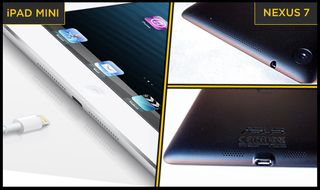
During “I Write Sins Not Tragedies” by Panic at the Disco, the string plucks and bells rang out loud and crisp on the iPad mini, but we picked up some static on the Nexus 7. While listening to “Technologic” by Daft Punk we picked up a little bit of bass from the iPad mini, but it was totally lacking from the Nexus 7.
Plugging in headphones definitely increased the volume and quality of the audio on both tablets. However, the levels on the Nexus 7 with headphones in was so much louder we nearly blew out our eardrums at full volume.
Winner: Apple iPad mini. The quality, depth and volume of Apple’s tablet beats the Nexus 7.
Interface
The Nexus 7 is the first device to run Android 4.3, the latest version of Google's tablet and phone-based OS. But it’s not a complete overhaul. You're still presented with the same lock screen as Jelly Bean 4.2, which means you can unlock the Nexus 7 to the home screen or directly to Google Now, but not the camera or app of your choice. You can also launch separate profiles with app restrictions for kids, from the lock screen.
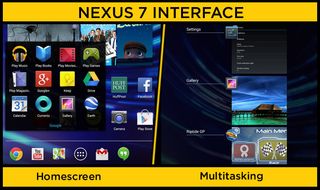
Swiping drop-down from the top of the screen (from left edge to center of tablet) reveals the notification menu, while swiping down from the top right side displays the quick settings menu, which includes Brightness, Wi-Fi, Auto-Rotate and Airplane mode. The Back, Home and Menu buttons sit along the bottom.
Switching apps on the Nexus 7 is as easy as pressing the Recent Apps button and selecting the live thumbnail of the open app. For now, iOS 7 presents only static icons when you double press the Home button.
You can still add all sorts of widgets, including Bookmarks, Flipboard, Gmail, Google Play Music and more on Android. As you download more apps, such as Spotify, you’ll be able to add widgets for those.
The iPad mini currently runs the same iOS 6 software and has the same interface as the regular iPad. You'll find the familiar home screens with app icon shortcuts, along with a launcher bar down below that accommodates up to five of your favorites. The UI is as intuitive as ever, but it's also getting a little boring compared with the Nexus 7. Fortunately, iOS 7 will add such features as a Control Center for tweaking settings and improved multitasking.
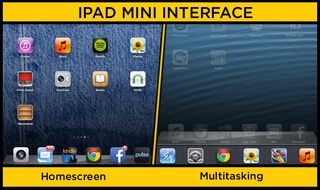
Winner: Google Nexus 7.
Android allows much more freedom in customizing the look and feel of your tablet and (at least for now) offers much quicker access to important settings. Plus, with profile support, the Nexus 7 makes things easier on families.
Parental Controls
Preventing your child from accidentally ordering a car on eBay is a real and serious concern. With the introduction of Android 4.3, Nexus 7 owners get access to User Profiles that allow an entire family to share a tablet safely and easily. By going into the Settings, parents can set a PIN or pattern to unlock the master profile. This is where you can set a Restricted Profile that prevents kids from accessing specific apps and content. Some apps, such as Email and Gmail, are not supported in this mode at all. The Google Play store is also disabled here, so your tech-savvy kids can’t download more apps.
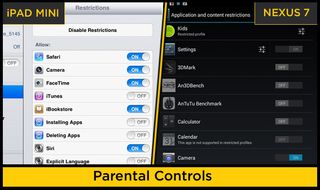
In iOS on the iPad mini you can set up Restrictions in the Settings menu, where you can allow or not allow access to specific apps. This menu is very limited, though. You’ll find only Safari, Camera, FaceTime, iTunes, iBookstore, Twitter, Facebook and Siri. You also can’t create separate profiles, so, if you share your device you have to go in and switch the restrictions on and off each time you hand-off the device.
There are some specific settings that you can tweak in iOS.
MORE: Children and Smartphones: What's the Right Age?
You can restrict the type of content (explicit movies, TV shows, apps, music) a child accesses by various rating systems. You can also prevent access to features such as podcasts, library sharing, in-app purchases, location services and multiplayer games.
Winner: Google Nexus 7.
Being able to have separate profiles for separate family members makes sharing a tablet so much easier.
Keyboard
Although we had to stretch our thumbs slightly, typing on the iPad mini's keyboard in portrait mode was fast and accurate. We typed email replies with ease. You can also switch to a split keyboard with a swipe. One thing you do not get is tactile feedback.
If you tap the microphone icon, you can dictate instead of type on the mini. The device successfully recognized our phrase, "My name is Anna Attkisson and I’m speaking as quickly as I can to see if you can keep up with me iPad mini." Apple’s device even spelled our name right. However, the mini heard “She was the saddest little thing you’d ever seen” as “She was this absolutely need ever seen.”
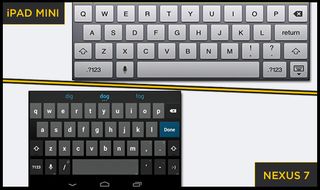
Sadly, you do have to be online to use voice typing on the iPad mini, which is not the case with the Nexus 7. Plus, because the Nexus 7's voice typing works offline, you can dictate faster. Google’s Nexus 7 understood more of our phrases than the iPad mini, but interpreted “Anna” as “an app to send”.
MORE: Android Type-Off: Which Smartphone Keyboard is Best?
The stock Android keyboard looks familiar, but Google has taken some cues from third-party options in terms of features. The keyboard supports Swype-style gesture typing, and we appreciate that floating previews appear above what you’re swiping over. We also like the current-word completion capability and next-word suggestions. Overall, typing was swift and accurate
Winner: Google Nexus 7.
You get trace typing, next-word prediction and offline voice typing. No contest.
Siri vs Google Now/Voice Search
Apple’s personal assistant, Siri, can help you with a remarkable number of things, assuming she’s connected to the Internet. For instance, Siri can set reminders, help you make dinner reservations via OpenTable, search the Web, give directions, tell you the weather, open apps, play music, send messages and even tell jokes (sort of). However, there is no central repository for Siri’s knowledge or a place to quickly glance at the information she has pulled up for you recently, as with Google Now. Also, Siri can’t translate phrases into other languages.
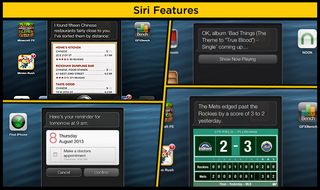
Accessing Siri is as simple as tapping the home button and starting to talk. In our experience, Siri understood our voice every time. Her jokes were fairly lame -- “What did one iPhones say to the other iPhone...hmmm, I used to know that one” -- but otherwise she was very helpful. Unlike Google Now, you can use Siri to look up movie times and by tickets.
Google approaches voice control a slightly different way, building Google Now into its Search App. Among other things, Google Now can tell you sports scores, the weather forecast, offer directions, set reminders, show your calendar, translate words and help with currency conversion.
You can access Google Now by touching the home button and dragging up to the word Google. Simply say Google or touch the microphone icon to activate the voice recognition. We found the voice recognition flawless, but Google’s voice assistant has no personality and is not as fully-functional as Siri. For instance, Google Now could not update our social networks, except Google+.
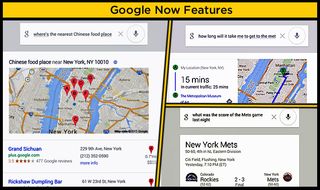
We tested both services for their contextual knowledge, and both fared well. For example, when asked “How did the Yankees do?” followed by “How about the Mets,” we got the most recent score on both devices.
Winner: Apple iPad mini.
Google Now is a bit faster and anticipates your needs, but Apple’s personal assistant is more versatile.
Apps
Being first and commanding more market share means more developers are on board with Apple’s App Store. That’s particularly true in the vast array of apps made for iOS tablets (375,000 and counting).
The Google Play store is improving (more than 1 million apps overall), but many choices are still just supersized phone apps. In fact, one report from Canalys says that Android tablets have only 52 of the 100 top App Store apps. With the latest version of the Play store, there is a new tablet section, where you can see highlighted apps that feature tablet support. There are 85 selections to browse through, most of which are games. However, that doesn’t mean those are the only tablet apps on Android, and that number is growing.
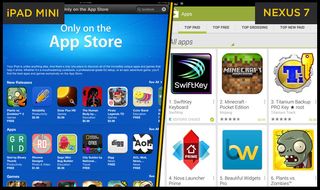
Facebook, for instance, is tailor made for tablets, and does not appear on that page. In fact, we prefer the Android Facebook experience to iOS because your friends appear in a swipeable menu that comes in from the right when you’re on the Nexus 7. While this feature exists on the iPhone app, it doesn’t appear in the iPad mini version. Wikipedia, which didn’t have an iPad app a year ago, looks identical on both OSes. CW TV was identical on both tablets. Twitter and LinkedIn look better on the iPad mini; on Android these apps are merely enlarged phone versions.
MORE: Best Apps 2014
Both app stores offer intuitive, easy-to-navigate user interfaces with top lists, categories and recommendations based on your previous downloads. And both stores stock just about any app you could want.
However, Apple does still have a few desirable exclusives such as Paper, Digg News and Twitter Music. All of these exclusives can now be found in a special tab called “Only on the App Store.”
Winner: Apple iPad mini.
Until Google can up its tablet app count significantly and get more developers on board for tablet optimized apps, the iPad mini wins.
Content
You can get Amazon, Barnes & Noble, HBO Go, Netflix, Hulu Plus, Crackle and several other third-party providers through the Apple and Google app stores, but each of these device makers also have their own digital stores. Both Apple and Google offer games, podcasts, books, magazines, movies and TV shows, and music. You can rent or buy movies and TV shows, and the selection of all of this content is comparable on both tablets. Likewise, prices and selection of music is comparable. But the two stores are different.
When it comes to e-books, you’re best off downloading Amazon’s Kindle app. Apple would be a runner-up, and Google our last choice. From among the New York Times list of the 15 best-selling e-books, Amazon had all 15 and almost always offered the lowest prices of all three. Apple matched Amazon’s price on 11 of the 15 titles, while Google only matched five. In fact, in a couple of cases, prices were significantly higher on Google Play. “Ender’s Game,” for instance, will cost you $7.59 on Google Play, $3.99 on iBooks and $3.49 on Kindle. Similarly, “The English Girl” by Daniel Silva goes for $11.99 on Kindle and iBooks, but $15.29 on Google Play.
We found the same list of Oscar-winning movies on iTunes and Google Play. From among Neilsen’s top 10 timeshifted TV shows of 2012, iTunes had one more (Mad Men) than Google Play. Similarly, only one of the Alliance of Audited Media’s top digital magazine’s couldn’t be found on Google Play (National Geographic).
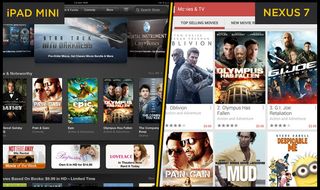
The Nexus 7 is among the first devices to get Google Play Games, which allows multiplayer fun with your friends and offers social discovery of games through Google+. This is Google’s answer to Apple’s Game Center that works similarly.
On the few multiplayer enabled games on Play you can sign up to play a complete stranger. In “Riptide GP 2,” one of the games that has enabled the new feature, we didn’t see the other player or his rider. But we did get notified that the game was over after he had won.
Apple’s Game Center, by comparison offers very similar functionality in a stale design. With the introduction of iOS 7, Apple’s Game Center will get a full redesign, removing the previous skeuomorphic look.
MORE: 10 Best Entertainment Apps for Tablets
In addition to letting users upload music to the cloud, Google Play Music offers unlimited on-demand streaming from the Nexus 7 for $8 per month. You can also create custom radio stations, and get contextual music recommendations.
Apple’s iTunes Radio is not yet available. When it is available for download this fall, you’ll be able to sign up for an annual subscription to iTunes Match for $24.99. With both, you will be able to store all your music in iCloud, plus you’ll get ad-free customizable radio. iTunes Radio will also let you create a wish list of songs to buy from iTunes later.
Winner: Apple iPad mini.
It’s a close call on this round, because both Apple and Google offer very similar types of content. While Google wins on music, for now, books are more expensive on Google Play, and iTunes offers a minutely better selection of movies and TV shows.
Performance
The iPad mini uses the same A5 dual-core processor that powers the the iPad 2, so you should expect fluid (but not blazing) performance. Alternatively, the Nexus 7 comes packing a 1.5-GHz Qualcomm Snapdragon S4 Pro processor, 2GB of RAM and a 400-MHz Adreno 320 GPU.
To gauge the performance of these two tablets, we ran Geekbench 2, which measures the processor and memory performance. The iPad mini with LTE scored a paltry 761 (on Wi-Fi only model the score was 753) compared to the Nexus 7’s score of 2,678. That’s more than three-times faster. It’s also worth noting how much faster the category average is at 2,328.
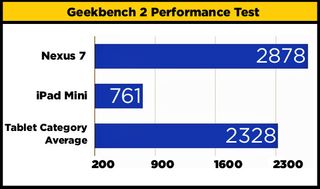
We got an even more clear picture of overall performance when we ran the Passmark app, which evaluates everything from CPU and disk performance to memory and 2D and 3D graphics. The Nexus 7 scored 3418 versus 1967 for the iPad mini.

When measuring graphics performance using the GFXBench app’s test for T-Rex HD Offscreen Fixed timestep, we watched an animated scene of a T-Rex chasing someone riding a motorbike through the jungle. The Nexus 7 once again stomped all over the iPad mini running at 16 fps versus 3.4 fps.
The Nexus 7 won again on the Web-based Sunspider 1.0 Jbench 2avaScript test, where we were looking for the lower score of the two tablets. Google’s 7-inch tablet scored 1147.3 milliseconds, and the iPad mini lagged behind with a score of 5541.7 ms.
MORE: Top 10 Tablets to Buy (or Avoid) Now
For everyday usage, the Nexus 7 generally proved more snappy. Opening “Despicable Me: Minion Rush” took 34 seconds on the iPad mini and 27 on the Nexus 7. The cameras loaded nearly simultaneously and keyboards appeared just as quickly on both, but opening email was faster on the Nexus 7.
When it comes to storage space, neither device offers expandable storage. Both come in 16GB and 32GB models, so, in that at least, there’s a tie.
Winner: Google Nexus 7.
From benchmarks to everyday use, Google’s 7-inch slate simply proved faster and more responsive.
Camera and Camcorder
Apple includes a 5-megapixel rear camera and a 1.2-MP front camera on the iPad mini. Google’s Nexus 7 packs cameras on the front and back that support identical megapixels. And both tablets can shoot 1080p video.
There aren’t any real settings to tweak on the iPad mini’s camera. It’s simply point and shoot. We do wish the camera on the iPad mini supported the same Panorama mode as the iPhone 5 and latest iPod touch. You don't get an HDR mode, either. But you do get built-in image stabilization, thanks to the A5 chip.
The camera app on the Google Nexus 7 does offer more settings, including the ability to change the resolution, white balance, scene mode and exposure. Sadly, the only way to change these settings is to use both hands, because the buttons are in the middle of the screen. Also, you can't back out of menus incrementally, so if you're in a sub-sub menu, you have to start all over from the beginning if you want to change something else.
We do love the Photo Sphere feature, which takes Panorama mode to a whole new level. You can take a hemispherical image in a few easy steps.
We took the the streets of New York City to test out these two similar cameras. On shots of flowers, the Nexus 7 captured more realistic, colorful and detailed photos than the iPad mini. It also snapped a sharper picture of the Empire State Building taken from a distance.
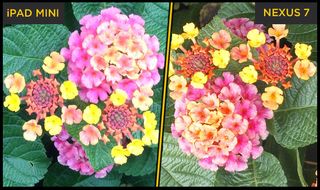
When we headed back inside, the colors on the iPad mini popped more, until we turned off the lights. In a low-light situation we could hardly make out any detail using the mini. However, the Nexus 7’s low-light shots were much more grainy looking.
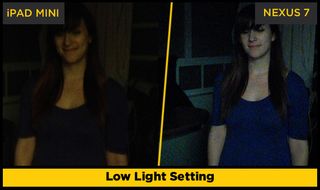
We took selfies using the two tablets’ 1.2-MP front cameras. The iPad mini’s skin tones were brighter and more accurate. On the Nexus 7 we looked dull and lifeless, by comparison.
Lastly, we shot 1080p video of New York City traffic on both tablets. The iPad mini’s video didn’t shake as much, but it was grainy looking compared to the Nexus 7.
Winner: Google Nexus 7.
While it’s not super easy to alter settings on the camera, the Nexus 7 snapped sharper and more colorful photos outdoors. Video was cNexusrisper on Google’s tablet, too.
Battery Life
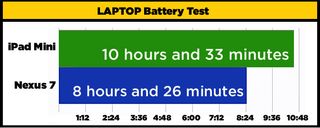
On the LAPTOP Battery Test (continuous Web surfing via Wi-Fi at 40 percent brightness), the 3950 mAh battery in the Nexus 7 lasted 8 hours and 26 minutes. That’s impressive; about 1:20 longer than the category average and an hour longer than the original Nexus 7.
MORE: 10 Tablets with the Longest Battery Life
However, on the same test, the iPad mini lasted an epic 10 hours and 33 minutes. Plus, over LTE the mini still lasted longer than average at 8:16.
Winner: Apple iPad Mini.
The endurance is simply better.
Accessories
For a reasonable $39, you can outfit your iPad mini in one of six Smart Cover options that magnetically attach to the tablet. Smart Covers can prop up the slate. Apple also sells a number of Lightning adapters, including a USB Camera adapter and an SD Card Camera Reader (both $29), as well as a VGA and Digital AV Adapter (both $49).

Google doesn’t currently sell any accessories for the Nexus 7, but a sleeve for the tablet is listed as Coming Soon for $29.99. Many third-party accessories are sold online, but many more add-ons are available for the iPad mini. The range varies from keyboard cases and camera connection kits to speaker docks, car docks and more.
Winner: Apple iPad mini.
There are simply more accessories available for the iPad mini that add functionality and style.
Overall Winner: Apple iPad mini
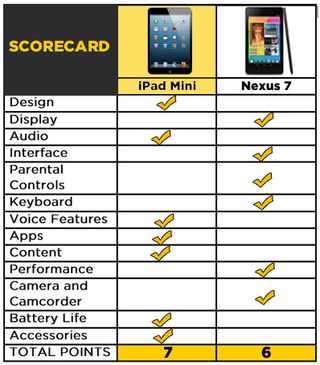
This was a very tight race, but the 7.9-inch iPad mini squeaks out the victory by a score of 7 rounds to 6. Apple’s small tablet offers a more premium design, superior audio quality, a more helpful voice controlled assistant and a better selection of apps tailor-made for tablet use. Plus, you get longer battery life and a broader array of accessories. And with iOS 7 around the corner, iPad mini owners will soon be able to multitask and tweak settings more easily.
However, for those on a budget, the $229 Google Nexus 7 is an excellent choice. For $100 less than the iPad mini, you get a brighter and higher resolution display, blazingly-fast performance, a better keyboard and a superior camera. Families will very much appreciate the Nexus 7’s ability to support multiple profiles and approve apps for their children to use.
While it’s a close call, the Apple’s iPad mini brings home the winner’s cup for the best small tablet around.

